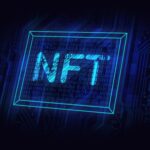Non-fungible tokens (NFTs) broke out into the mainstream for the majority of 2021. Digital art was the name of the game, and the rich and the famous were unashamed to promote it. As retail investors were pouring their hard-earned money into these collectibles with no real intrinsic value, the blue chips of the world were quietly improving upon their existing NFT-based supply chain infrastructure. Unfortunately, most NFTs turned out to be scams or worthless, but Wait, what? Do NFTs have use cases other than digital art? Buckle up your seat belts because we’re going to dive deep into the world of enterprise blockchains and explore how NFTs are the lifeblood of companies worldwide.
Enterprise Blockchains Are For Grown-Ups
If pixelated digital artworks are for kids, enterprise blockchains are for grown-ups. When people think of NFTs, they automatically picture pixelated digital artwork such as Crypto Punks or cartoon-styled collections such as Bored Ape Yacht Club. No one thinks of big corporations getting into NFTs or blockchain technology. Sure, we’ve seen the likes of Coca-Cola and Nike dip their toes into the NFT space with releases of their brand-specific mints. However, the more supply chain-focused companies have already deployed their own NFT-based infrastructure.
Companies that have incorporated enterprise blockchains include IBM, CISCO, Amazon, Intel, Walmart, and CitiBank to name a few. Their use cases vary slightly but they are after the same thing: tokenizing items and tracking them through the logistical mazes that are prevalent in their respective supply chains. Digital art NFTs achieve one thing right and that is to establish verifiable ownership in that item. NFTs as they are used in enterprise blockchains take it a step further and track these unique items throughout each phase of the product lifecycle.
A November 2021 report by Brandessense research revealed that in 2020, the global tokenization market was valued at $1.8 billion and is currently on track to reach $6.3 billion by 2027. During this forecast period, a 19.4% compound annual growth rate is expected. The report identifies cybercrime and fraud as some of the major driving factors for this shift towards tokenization. Virtually all industries from all around the globe are adopting tokenization into their business operations in some way, shape, or form. Tokenization is taking over the world, and no, it isn’t because of digital art NFTs.
The report highlights financial services, retail, healthcare, automotive, and other industries as the main adopters. Why is it that these seemingly unrelated industries are coalescing towards tokenization? It’s simple really – tokenization provides a way to track unique and authentic items throughout their business processes in an efficient and immutable manner. This is why the supply chain-focused corporations mentioned earlier have already adopted this technology and some are even developing their own enterprise blockchains which can be implemented in practically all businesses (more on this later).
Peering Into Tokenized Supply Chains
Have you ever ordered a product online and wondered where your package is? The tracking details give an overview of where it is and at best it provides an estimate of when you should expect your delivery. All of these assumptions work towards easing your anxiety, for the most part, that is until your package gets lost in transit. Logistics, or the process of managing the flow of goods from one source to a final destination, is an important part of the supply chain that is typically the most visible to the end customer. Though countless companies are utilizing enterprise blockchains in their supply chain let’s take a look at two active use cases.
Nestlé Is Tracking The Coffee Beans To Your Cup
What happens before the creation of the tracking number is a complete mystery to most but companies like Nestlé are implementing tokenization in their supply chain via Amazon Managed Blockchain to promote transparency. Nestlé’s consumer demand pushed the company to create the ‘Chain of Origin’ project to prove the authenticity of their single-origin coffee. The company developed processes to track micro-batches from coffee beans to the customers’ cups. By utilizing Amazon Managed Blockchain to tokenize its processes they were able to hit two birds with one stone. Consumers were happy because they now have the coffee’s single-origin proof to back up their claims and Nestlé’s partners, such as farmers and roasters, were happy because they can now see where the batches are in the supply chain.
Why does it matter if the coffee bean roasters knew where the beans are and when they will arrive from the farmers? Remember the packages you ordered that have been lost in transit? They were lost because of inefficiencies in current tracking systems such as barcode scanning, manual logging of inventory, and forwarding packing slips to the shipping department before the truck leaves for the day. The root causes are be attributed to human error and inefficiencies in these instances.
Imagine that there are no barcodes to scan, nor any worker to scan them. Instead, tokens are assigned to product metadata, and simply passing through an IoT-powered staging area would clear, reject, or direct it based on its properties. With Nestlé, now that they have complete visibility on every batch throughout their supply chain, they don’t have to spend time picking up the phone to chase down a batch to figure out why it was delayed or where it is – they can simply take a look on the blockchain. The tokenization of the coffee bean batches streamlines logistics while serving as a real-time tracking indicator in their supply chain.
Dole To Overhaul Their Supply Chain Management
When you think of canned pineapples you immediately think of Dole. The Dole Food Company is undoubtedly one of the most familiar players in the fruit and vegetable distribution game and for good reason. Being a household name since 1850 helps but what happens behind the scenes is truly remarkable. With their vast network of partners all contributing to the success of their product, one can only imagine how intricate their operations can get.
Food distributors like Dole generally keep out of the limelight unless something bad happens like a salmonella outbreak or a product recall. However, being the forward-thinking company that they are they have already put in motion a plan to introduce enterprise blockchain into all of their departments by 2025. Their blockchain weapon of choice is IBM Food Trust and it will be used to monitor and track vegetables throughout their entire life cycle.
Dole’s Corporate Responsibility and Sustainability Report 2020 stated that “Produce that’s been logged via blockchain can be instantly traced back through the supply chain, giving retailers and consumers confidence in the event of a recall.” One of their end goals is to provide full transparency to the end consumer. They go on to report, “Eventually, consumers will be able to scan each bag of salad or package of vegetables in-store to get information about its journey from farm to store shelf.”
What Choices Do You Have For Your Business?
Do you have products or services that traverse through different departments before being shipped out? Can your operations be optimized if the transit of raw materials from various sources were tracked in real-time? Can you streamline assembly and reduce verification times by removing human input? Would your product gain more trust from the end consumer if the product’s sourcing and lifecycle tracking were transparent?
The main value proposition for enterprise blockchain integration into businesses is tracking, monitoring, identifying products, and processes through tokenization. Applications for tokenization are seemingly limitless and there are plenty of enterprise blockchain options to choose from. Tokenizing assets and tracking their every movement might not be something that companies will want to share with the world. Their trade secrets and data are typically proprietary and thus, permissioned blockchains, where transparency is controlled and limited to those who need to know, are the way to go.
Hyperledger Fabric
Businesses typically don’t use public blockchains because of their decentralized and transparent nature. Instead, they will use permissioned blockchains like Hyperledger Fabric to establish a framework where they can build smart contracts, applications, and databases. All parties that want to connect to the framework have known and verified identity which is validated against the company’s identity management system. This means that there are no anonymous users and every action they take can be traced to a unique individual. Users are authenticated via the issuance and validation of certificates.
The performance and scalability are a selling point for Hyperledger Fabric. Over 1200 expert developers are available to help set up your business and this number is growing every day. With massive support from companies like Oracle, Huawei, IBM, and Intel behind them, it’s more than likely that their enterprise-grade solutions will continue to evolve and cater to your business needs.
Amazon Managed Blockchain
Setting up a permissioned blockchain can be daunting especially if your company doesn’t have developers or the necessary knowledge to set one up. Amazon Managed Blockchain simplifies the process by providing a wizard-type service where they ask questions and help guide you through the setup. The end goal to have a tokenized network is the same with any enterprise blockchain but Amazon Managed Blockchain makes it easier to build it and set up the security and certificates that users will need to navigate. Users can join public networks or create private networks across Amazon Web Service (AWS) accounts using open source frameworks.
Amazon Managed Blockchain uses Hypderledger Fabric and Ethereum as the framework so you can rest assured that their features apply here too. This means networks are scalable, fast, reliable, and data is secure. The key difference between Hyperledger Fabric and Ethereum is that the former is permissioned while the latter is permissionless. If setting up a network quickly and seamlessly is your goal, Amazon Managed Blockchain would be a great option. However, make sure to understand which ledger type you want to use for your business.
NFTs Will Continue To Evolve
As NFTs continue to break records in digital art sales, in the world of enterprise solutions, networks of permissioned blockchains continue to evolve. Tokenization of parts, products, and assets in a supply chain is a popular use case amongst industrial food and beverage giants but its applications are being utilized in industries such as financial services, banking, insurance, retail, and healthcare to name a few. It is clear that tokenization can be used in any industry in virtually every department within a company. Currently, the main adopters of this technology are large-cap companies but as blockchain literacy spreads throughout the world, we will likely see tokenization trickle down to the consumer level.
What’s an NFT and How Can NFTs be Used in Real Estate.
This post was written by Ironsung on Fiverr. I hire Fiverr writers who know these topics very well so that we can all learn more about the various subjects shared in this blog. Subscribe for more investing posts. Have a lovely day.
Disclaimer
I want to make it unequivocally clear that I do not promote any cryptocurrency, nor do I endorse any crypto investments. This website is dedicated to providing information and insights into the world of cryptocurrencies to help you better understand what crypto is. If you ever find yourself in a position where you need to explain your decision not to invest in cryptocurrencies to friends or acquaintances, you can use the content on this site as a guide to discourage people from falling victim to scams or making hasty financial decisions. My ultimate goal is to empower individuals with knowledge and awareness so that fewer people become financial victims. Life is already challenging with its inherent obstacles; we don’t need the added burden of unscrupulous individuals looking to exploit our hard-earned money. Stay vigilant, stay informed, and make financial decisions with caution. Your financial well-being is of paramount importance, and it is my sincere hope that the information here can assist you in making prudent choices.











